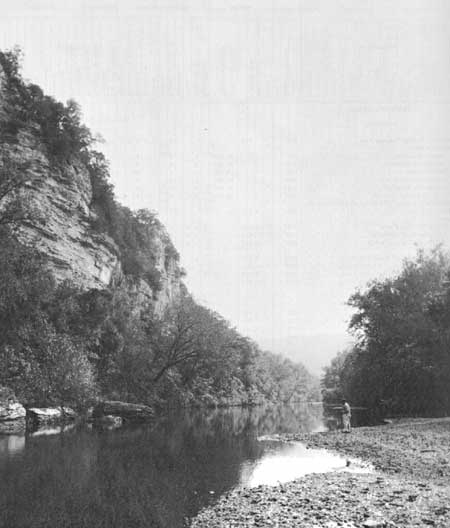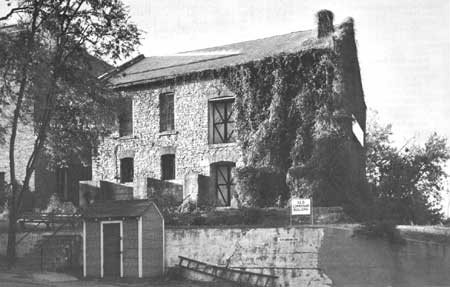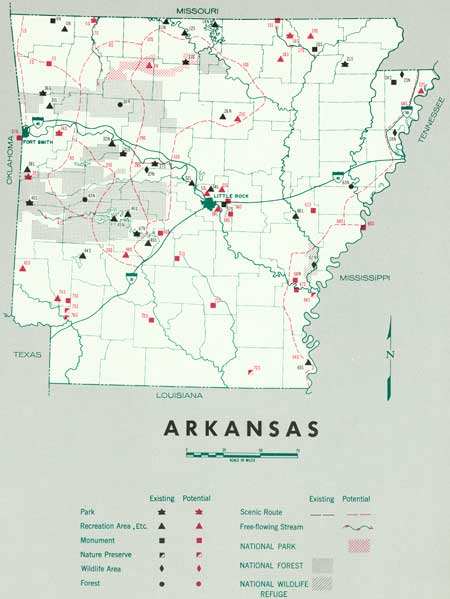.gif)
Parks for America
MENU
|
Parks for America
|

|

|
| The Buffalo River, one of Arkansas' most renowned free-flowing streams, merits protection as a national river. |
ARKANSAS
ARKANSAS is generously endowed with outdoor recreation resources to serve central United States from the Gulf of Mexico to the Great Lakes.
Arkansas was one of three States to experience a decrease of total population between 1950 and 1960. The loss occurred in rural areas and small communities. Urban population increased 21 percent. Density ranges from 6.9 in Montgomery County to 316.6 in Pulaski County. Projections indicate State population will decrease from 1,786,272 in 1960 to 1,406,000 by 1976.
Agriculture is the leading industry, amounting to $700 million a year. Manufacturing and forest products together rank second, with tourism a significant third at an estimated $427 million per year.
The State highway system provides good access to all recreation areas. Rail and air facilities make connections to major resort areas such as Hot Springs. Arkansas has extensive mountains, attractive streams and artificial lakes, abundant fish and wildlife, extensive forests, interesting geology and history. Year-round outdoor activities can be enjoyed in a climate that is warm and humid in the summer and mild in the short winter season.
The terrain ranges from mountains in the northwest to river plains in the southeast. More than half the State is forested, with 15 percent in public ownership. Lakes and streams cover 822 square miles, with nearly 3,000 miles of navigable rivers. Spring-fed mountain streams run clear most of the year. Diversified hunting is of regional and State interest, and the recreational use of the Mississippi Flyway for photography and nature study has great potential. Archeological evidence, several thousand years old, adds to a history dating from De Soto's discovery in 1541.
EXISTING PUBLIC AREAS
NATIONAL: The National Park Service administers one national park of 989 acres and one national military park of 4,211 acres. The 1960 attendance was 719,100. The Forest Service administers 3 national forests totaling 2,388,949 acres, with 28 areas developed for recreation. The 1960 attendance was 1,824,400. The Bureau of Sport Fisheries and Wildlife administers four national wildlife refuges with a total of 133,269 acres. There are six Corps of Engineer reservoirs (two partly in adjacent States) that have a total of 194,050 water-acres in Arkansas. The attendance figure for 1960 was 6,755,900.
STATE: The State Publicity and Parks Commission administers 19,123 acres in 14 parks that had a total attendance of 2,993,800 in 1960. There are 111 road side parks under the State Highway Department.
LOCAL: There are three nonurban city parks totaling 1,862 acres and two water-supply reservoirs with 3,850 water-acres.
PRIVATE ENTERPRISE: Recreation accommodations and facilities for considerable numbers of people are provided by private enterprise in the mountains, along streams and rivers, and at major reservoirs.
On many natural and manmade lakes, private holdings seriously reduce public access and use. Substantial forest holdings of major wood industries are open to public hunting and related recreational activities.
PARK AND RELATED NEEDS
Recreational development in better relation to population distribution is a critical need. Future Corps of Engineers projects in the northeast and near the southwest corner of the State will partially fill this need. To meet the growth of demand, full utilization of the potential of present and future impoundments will be required.
Free-flowing streams are an irreplaceable part of the distinctive natural scenery of the State, and their preservation for public recreation is desirable to balance the role of artificial impoundments.
Arkansas' creditable State Park system falls short in numbers and scope of areas when considering its potential. It should be properly representative of the State's important and diversified scenery, natural features, and human history. Its facilities are over taxed, impairing park resources in several areas.
The delta communities and the larger cities are especially lacking in recreation facilities.
Population projections indicate that the midlands of America will exceed 50 million by the year 2000. The shift to urbanization, industrial development, and the influx of retired and semiretired people attracted by climate and recreation opportunities are important considerations in Arkansas' future recreation needs.
Existing State recreation areas now provide 19,123 acres for the 1,786,000 residents, and local parks provide 1,800 acres. Potential areas identified in this plan total 31,100 acres of State significance and 4,000 acres of local significance. Even if all these potential areas are acquired and developed, there will remain an unfilled need, and additional areas should be selected and developed to provide well-distributed and adequate State and local parks by 1976.

|
| Fort Smith National Historic Site, recently authorized, will commemorate one of the earliest U.S. military posts in the Louisiana Territory. This commissary building is part of the second fort built here, soon after Arkansas became a State. |
RECOMMENDATIONS
Existing recreation resources and many potential areas are shown on the accompanying tabulation and map. Vigorous action by agencies concerned is urged to implement the following recommendations, offered to help provide needed outdoor recreation opportunities.
NATIONAL: Establishment of Fort Smith National Historic Site and Arkansas Post National Memorial as authorized by Congress. Establishment of a Buffalo National River.
STATE: Expansion of the State park system to protect valuable resources by addition of four parks, seven monuments, three recreation areas, and further study of four recreation areas, four monuments, and four nature preserves as possible additions to the system. Designation and protection of eight scenic roads and three free-flowing streams. Expansion of acreage and facilities in certain existing parks.
LOCAL: Further study on the establishment of three recreation areas and one scientific monument.
Supporting recommendations include—
1. Expansion of the staff of the State Publicity and Parks Commission to include professional park planners.
2. Enactment of legislation to establish scenic routes and provide a statewide system of interpretive waysides to present the "Arkansas story," with descriptive material on State history, natural history, geology, and economics.
3. Continued planning and development of the Great River Road in cooperation with the Governor's Commission.
4. Enactment of Federal and State legislation to assure sufficient shorelands in public ownership on all impoundments to serve recreation needs and preserve scenic, scientific, and historic features.
5. Development and maintenance of adequate wayside parks along State highways. Where highway rights-of-way are adjacent to or cross streams or lakes, provision for public access to these waters and construction of launching ramps and parking areas.
6. Encouragement to counties and community subdivisions to establish recreation areas and provision of technical assistance through the Publicity and Parks Commission.
7. Establishment of an adequate system of nature preserves within the State park system and through conservation organizations to include caves, the original Grand Prairie vegetation, the Ozark white oak forest, and a swamp habitat.
(Table omitted from online edition)

|
| (click on image for an enlargement in a new window) |
NEXT >>>
|
|
Last Modified: Mon, Sep 6 2004 10:00:00 pm PDT
parks_america/arkansas.htm
 Top
Top